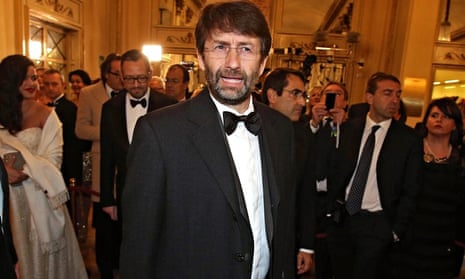Italy is turning to the private sector to try to increase the profitability of some of its cultural treasures, including the Uffizi gallery in Florence and Borghese gallery in Rome.
Under a new initiative sponsored by the government of the prime minister, Matteo Renzi, Italy’s cultural centres are likely to begin to look more like other great museums around the world, including the Metropolitan Museum of Art in New York, by opening more restaurants, gift shops, ticket booths, guides, and other tourist-friendly additions that can start generating bigger profits.
The museum decree, expected to be unveiled this week by Dario Franceschini, the culture minister, will create 18 new offices for the biggest artistic sites in the country.
These offices will begin to accept private sector bids from Italian and international companies to build up some of the museums, with the aim of raising about €2bn (£1.6bn) per year by 2017.
It will be hard to do much worse than the current state of affairs, where only 190 of Italy’s 450 state museums offer any additional facilities to tourists.
Italy’s museums and archaeological sites made only €380m in sales last year and, according to La Repubblica, generated profits of just €30m, or 50 cents per Italian citizen.
By comparison, the Louvre in Paris, home of the Mona Lisa by Leonardo da Vinci, generated €2.5bn in sales last year.
The Italian press reported that the restaurant at the Metropolitan Museum of Art in New York in itself made more money alone than all of the Italian museums combined.
“We’ve inherited an intolerable situation,” Franceschini said recently, according to La Repubblica. “There is no activity of the state that is even capable of running a bookshop.”
Italy is the fifth largest tourism destination in the world and hosted an estimated 47.7 million foreign visitors in 2013, according to the UN World Tourism Organisation rankings.
For a country facing record unemployment and a third recession, the great artistic and cultural venues that are spread from Naples to Milan have long been seen as a possible cash cow.
But change has been slow.
In 2009, a former director of McDonald’s called Mario Resca, who served as the general manager of Italy’s state-run museums, caused a stir when he called for some of Italy’s cultural centres, including the Colosseum, to be made available to private parties for special events.
Now it is Franceschini who is trying to shake up the moribund Italian tourism sector, and that could lead to better services – and higher prices – for visitors.
In July, Franceschini unveiled what were deemed to be revolutionary changes at the Uffizi, as well as at other state-owned museums, when he announced that only visitors under the age of 18 would be given free tickets and those under 25 would be given reduced tickets. Before the change, some senior citizens received steep discounts.
Franceschini has also encouraged greater corporate involvement in the Italian arts. Earlier this month, the minister hailed Samsung Italia, a division of the South Korean conglomerate, for its €600,000 investment in the Gallerie dell’Accademia, Venice.
He said the investment in the museum ought to serve as an example to other companies looking to do their part to protect Italy’s cultural heritage.
The funds paved the way for the gallery to double its exhibition size to 10,000 sq m and will triple the number of expected visitors from 300,000 per year to 900,000.
Not everyone is enamoured by the idea of museums seeking alternative ways to generate income, however.
Marco Pierini, the director of the civic gallery in the northern city of Modena, resigned this month after his museum opened its doors to a food exhibition that showcased local specialities such as mortadella and balsamic vinegar.
“It seems to me that to evict art and replace it with typical products, creates the image of a city that caters to consumer tourism, rather than thoughtful citizens,” he said in his resignation letter.

Comments (…)
Sign in or create your Guardian account to join the discussion